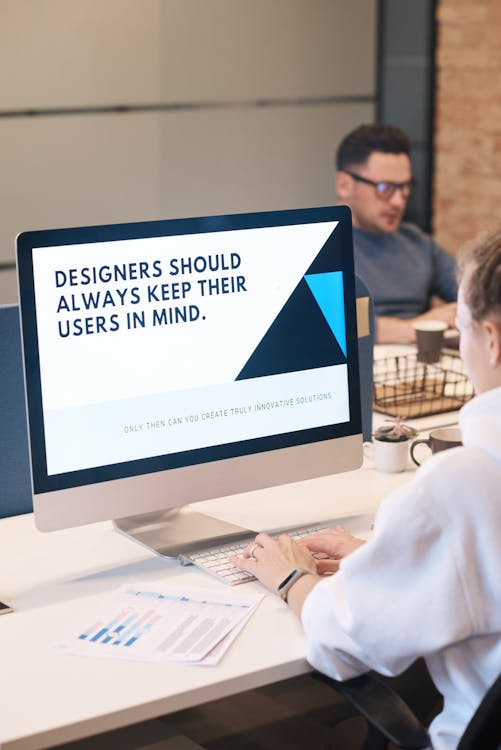The Future of UX/UI: From Static Screens to Adaptive Systems
4. The Future of UX/UI: From Static Screens to Adaptive Systems

The interface is no longer just where humans meet machines—it’s where brands meet expectations. In today’s digital landscape, users demand experiences that are not only beautiful and fast, but deeply personal. Artificial Intelligence is stepping in to make this happen, allowing designers to build interfaces that learn, adapt, and evolve with every click, swipe, and scroll.
What was once a painstakingly manual process creating prototypes, testing variations, and translating experiences for audiences is now being reimagined through intelligent systems that can generate, optimize, and personalize designs at scale.
Table of Contents
4.1 The Tools Redefining Modern UX/UI
A new generation of AI-powered tools is empowering designers to move faster, test broader, and deliver experiences more precisely tailored to individual users.
Framer AI
Framer, already known for its high-fidelity interactive prototyping, now includes AI-powered layout generation. Designers can describe a desired outcome in plain language—“Create a pricing page with three plans and testimonials”—and Framer AI generates the layout instantly. This reduces design iteration time by up to 60% and allows for rapid testing of variations.
Uizard
Uizard enables instant transformation of hand-drawn sketches or wireframes into editable digital prototypes. It also includes design assistant capabilities, such as automatically generating UI components, recommending color palettes, and even writing microcopy. It’s widely used in startup ecosystems to turn early concepts into tangible, testable UI mockups within hours.
Galileo AI
Trained on thousands of real-world product interfaces, Galileo AI lets users generate polished UI mockups simply by describing product features or goals. It acts as a design assistant, reducing the burden of repetitive tasks and offering stylistic consistency across products. It’s especially useful for product teams with limited design bandwidth.
As highlighted in Section 3.2, Real-World Applications, of the May edition of HonestAI, this segment explores how cutting-edge technologies are being implemented across industries to solve real-world challenges and drive measurable impact.
4.2 Capabilities That Scale Design Intelligence
AI is bringing capabilities to the UX/UI process that were previously out of reach for most teams,especially when scaling across languages, user segments, or behavioral patterns.
-
Rapid Prototyping: What used to take days or weeks—wire-framing, styling, content placement—can now be done in minutes. AI handles the heavy lifting, allowing human designers to focus on refinement and storytelling.
-
Multilingual Adaptation: Tools now support instant content localization, automatically adjusting layouts for text expansion, direction (e.g., left-to-right vs. right-to-left), and cultural tone. This makes it easier to scale experiences globally without expensive translation and localization cycles.
-
Behavior-Driven Personalization: AI-powered analytics platforms can dynamically adjust UI elements in real time based on user data—offering personalized calls-to-action, product suggestions, or even layout adjustments based on scroll patterns and engagement behaviour.
For example, Netflix’s AI-driven UI adapts thumbnail images for the same content based on user profiles action scenes for thriller lovers, character moments for drama fans. This personalized micro-design has been shown to improve engagement by over 20%.
4.3 The Role Shift: UX Designers as System Architects
As AI takes on more of the design execution—automating layouts, generating components, and adapting interfaces in real time—the role of UX/UI professionals is undergoing a fundamental transformation. They are evolving from interface builders into strategic system architects, guiding intelligent experiences that learn, adapt, and personalize over time.
From Designing Screens to Designing Behavior
AI now generates wireframes, adjusts UI elements based on user data, and recommends content layouts autonomously. UX designers no longer spend their time pushing pixels—they curate, train, and guide AI systems that generate these designs at scale.
New Role: Designers as design directors, steering AI toward desired outcomes rather than creating every element manually.
From Task Executors to System Thinkers
Instead of designing static flows, designers are now building experience ecosystems—modular frameworks that AI can plug into to deliver dynamic, context-aware interfaces.
This shift requires UX professionals to think like systems architects, considering how AI decisions affect the end-to-end experience.
Example: Personalization engines adapting UI components in real time based on user sentiment, behavior, or location—all modeled and governed by UX frameworks. From One-Size-Fits-All to Journey-Specific Thinking
AI enables hyper-personalized experiences—different users get different paths, layouts, or features based on device, preferences, or even emotional state.
UX designers now map adaptable user journeys that AI can interpret and optimize, ensuring consistency while allowing for flexibility.
Designers become scenario strategists, defining rules and intent, while AI executes variations at scale.
Designing with AI Means Designing with New Teammates
This evolution also demands cross-disciplinary collaboration. UX professionals increasingly work alongside:
-
AI trainers, who shape how models interpret feedback and data.
-
Data scientists, who uncover patterns in user behavior.
-
Behavioral psychologists, who ground AI-driven interactions in human-centered thinking.
Together, these teams are shaping products that don’t just respond—but learn, anticipate, and evolve.
In this context, UX designers increasingly collaborate with data scientists, behavioral psychologists, and AI trainers, creating a more interdisciplinary approach to product design.
4.4 The Big Picture: Human-Centered, Machine-Enhanced
AI isn’t replacing UX designers, it’s expanding their potential. By automating repetitive tasks and powering real-time, behavior-aware personalization, AI is freeing designers to focus on empathy, creativity, and long-term experience vision.
The result? Interfaces that feel less like one-size-fits-all templates and more like thoughtfully crafted conversations—tailored to the moment, the user, and the context.
As users grow to expect hyper-personalization, the winning digital experiences will be those that can adapt instantly, speak natively, and evolve intelligently. AI makes this possible, but it’s still the human behind the system who defines the voice, values, and vision of the product.
4.5 Designing with AI: A Creative Ally, Not a Perfect Partner
– An insightful interview with Shrutika Vibhute from GrayCyan.
The Evolution of Creativity with AI
Artificial Intelligence has transformed the creative process in ways we could only dream of a decade ago. From product design to visual branding and ideation, AI tools are now redefining what’s possible in design workflows. With the right prompts, AI delivers striking results—but the relationship between designer and AI is nuanced, especially when the human element of emotion enters the scene.
The Promise of AI in Design
Designers today rarely start from a blank canvas. Tools like Midjourney, DALL·E, and Adobe Firefly can generate highly specific visuals from a simple line of text. Imagine typing:
“A futuristic office layout in pastel tones, with natural lighting and cozy seating.”
Within seconds, AI delivers impressive renderings—acting as a springboard for conceptual development.
Top AI image generators often deliver highly accurate visuals—and in many prompt-based cases, designers report ~85–90% alignment with intended style or content. But emotional nuance and subtle narrative dimensions often require human refinement.
The Gap Between Precision and Perception
AI interprets emotion using data—statistical patterns, not lived experience. It can mimic melancholy or joy based on training data, but it doesn’t feel. Abstract human emotions—like restrained anger or hopeful resignation—often elude even the most advanced generative models.
That’s where the human designer steps in.
Real-World Scenario: When AI Almost Got It Right
I once worked on an editorial piece that required an image of a woman embodying both resignation and hope. I used an AI image generator, experimenting with detailed prompts: lighting, pose, emotional context.
The results were technically stunning, yet emotionally misaligned.
Some faces were too cheerful. Others looked defeated. None struck the balance I envisioned.
Eventually, I chose the closest image and fine-tuned it manually in Photoshop—adjusting the eye shape, lifting one brow, softening the gaze. That subtle human intervention transformed the image. It finally conveyed the layered emotion the story needed.
The Takeaway: Human-AI Co-Creation is the Future
AI is a powerful co-creator, but not the sole creator. It can generate the first 80–90% of a design rapidly, saving time and sparking ideas. But the final layer—the soul of the story—still requires human intuition and craftsmanship.
Design is not just about precision. It’s about intention—something only a human can fully grasp.
As we move forward, the creative process isn’t being replaced. It’s evolving. And in that evolution, AI is not the artist—but a brilliant assistant.
Contributor:

Nishkam Batta
Editor-in-Chief – HonestAI Magazine
AI consultant – GrayCyan AI Solutions
Nish specializes in helping mid-size American and Canadian companies assess AI gaps and build AI strategies to help accelerate AI adoption. He also helps developing custom AI solutions and models at GrayCyan. Nish runs a program for founders to validate their App ideas and go from concept to buzz-worthy launches with traction, reach, and ROI.
Contributor:

Nishkam Batta
Editor-in-Chief - HonestAI Magazine
AI consultant - GrayCyan AI Solutions
Nish specializes in helping mid-size American and Canadian companies assess AI gaps and build AI strategies to help accelerate AI adoption. He also helps developing custom AI solutions and models at GrayCyan. Nish runs a program for founders to validate their App ideas and go from concept to buzz-worthy launches with traction, reach, and ROI.
Unlock the Future of AI -
Free Download Inside.
Get instant access to HonestAI Magazine, packed with real-world insights, expert breakdowns, and actionable strategies to help you stay ahead in the AI revolution.






